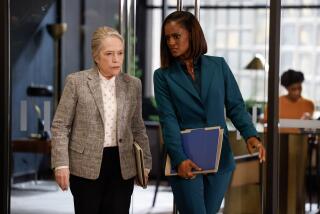Review: ‘True Detective’s’ slow and steady pace a winning formula
“True Detective,” a quietly terrific new series debuting Sunday on HBO, takes its title, though not its style, from a famous old real-crime magazine, popular back when people turned to reading for the sort of stimulation they get mostly through television now.
The title might be misleading — there is nothing fact-based about the show, but like its namesake it is planned as an anthology. As in FX’s anthology “American Horror Story,” each season will tell a discrete story — a strategy that, if nothing else, might attract commitments from name artists interested in long-form storytelling, or prestige television projects, but less sanguine about signing on to a series that could run for years. Matthew McConaughey and Woody Harrelson star in the first season, which has been entirely written by novelist Nic Pizzolatto and entirely directed by Cary Fukunaga (“Jane Eyre”).
FOR THE RECORD:
“True Detective”: A review of the HBO series “True Detective” in the Jan. 10 Calendar section said character Martin Hart, played by Woody Harrelson, was “a hallucinating insomniac.” The description was of character Rust Cohle, played by Matthew McConaughey.
The story here runs in flashback as two former police detectives, Rust Cohle (McConaughey) and Martin Hart (Harrelson), are interviewed separately about a 1995 murder case they worked together in Louisiana, near the beginning of their partnership. Hart is bigger and balder in the present day, a loquacious picture of respectability; Cohle, mustached, with long, stringy hair, seems to have fallen on hard times.
WINTER TV PREVIEW: Full coverage of the season’s shows
A hallucinating insomniac (“I don’t sleep, I dream,” he says, possibly quoting R.E.M.) who sees selfhood as illusory and religion as a trap, Hart is the sort who, in a lesser drama, would be the villain of the piece. (You do feel his interviewers think he might be.) But this is not a lesser drama.
“In philosophical terms, I’m what’s called a pessimist,” Cohle tells Hart.
“All right, what’s that mean?” Hart asks.
“It means I’m bad at parties.”
“Let me tell ya, you ain’t great outside of parties, either.”
For all that Cohle, a loner with a troubled past, seems dark, he knows what he’s about, while Hart, for all his presumed normality, is also grappling with chaos. “People give you rules,” Hart says. “Rules describe the shape of things.”
BEST TV OF 2013 Lloyd | McNamara
But he comes up short: married with kids, he’s also got a girlfriend on the side. He’s less comfortable than Cohle with the sense of things slipping out of his reach. And yet Pizzolatto doesn’t nail them to any schema; he gives each man his due, allowing each to be likable and less so by turns, and keeping the viewer from making up his mind — or at least from making up his mind too soon.
Many of the best detective stories are as much about the detectives as about the mechanics of whatever case they’ve caught, or have been caught in. Even when they’re not about the detectives, they’re about the characters the detectives meet, their jostling passage through a moral universe.
“Whodunit” is in many ways beside the point: It’s already happened. Getting to the answer — which even in some otherwise great stories can be unsatisfying — is a kind of mathematics. What surrounds it is a kind of philosophy.
There is more than a usual amount of dialectic at work here: As they travel from place to place, from trailer-park brothel to tent meeting to dance hall, Cohle and Hart talk about religion and existence and love and morality, uncomfortably but compulsively.
PHOTOS: Faces to watch 2014 | TV
We are seeing the return of the miniseries, reborn out of the seasonal long arc of the 8-to-13-hour dramatic serial. With no hurry to get to the end, there is time for slow, detailed storytelling with lots of room for conversation and for silence. Of course there are those who prefer that their answers come within the hour. But this is closer to the speed of life.
Like Jane Campion’s miniseries “Top of the Lake,” which aired on Sundance last year — and with which “True Detective” shares a talented cinematographer, Adam Arkapaw — “True Detective” runs slow and steady without ever seeming to drag. (Arkapaw’s work here recalls that of Southern color photographers like William Eggleston and William Christenberry; it has the slightly muted creaminess of physical color prints and argues in its way for the beauty of the world, as a kind of counterweight to the narrative.) Even minor characters get room to breathe, and seem independently alive; the briefest scenes seem to imply life beyond the frame.
Pizzolatto has a good ear for how people talk; his dialogue rarely sounds composed, though Cohle does have some fancy phrases to get through — “the ontological fallacy of expecting light at the end of the tunnel” and how life is “never anything but a jerry rig of presumption and dumb will.”
Yet McConaughey pitches his lines low, keeps them matter-of-fact, more so even than Harrelson’s presumably laid-back Hart. The dance they do together here is work of a very high order, and all the reason you need to watch.
-------------------------
‘True Detective’
Where: HBO
When: 9 p.m. Sunday
Rating: TV-MA (may be unsuitable for children under the age of 17)
More to Read
The complete guide to home viewing
Get Screen Gab for everything about the TV shows and streaming movies everyone’s talking about.
You may occasionally receive promotional content from the Los Angeles Times.







